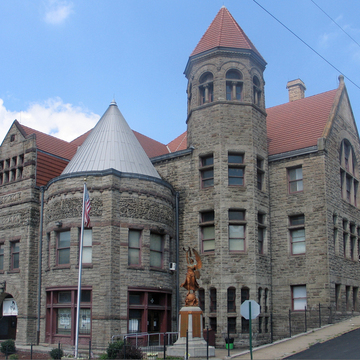A few minutes' walk from his Edgar Thomson steel plant ( AL57), this is the first library Andrew Carnegie donated in the United States, though he built it solely for his workers, not the general public. Lively in design and elegantly executed inside with costly woodwork, this library, with additions in 1893 of a music hall, gymnasium, pool, and baths, is programmatically part of the mills.
The original library is designed in Pittsburgh's ever-popular Richardsonian Romanesque, but departs from the majesty of the downtown Courthouse and presents, instead, a picturesque silhouette marked by the two squat towers flanking the entrance. One imagines that William Halsey Wood, in choosing the light gray stone of the structure, envisioned the effect the then ever-present dust and smoke would have. The taller tower rising above the roofline was meant to unite Wood's library with Longfellow, Alden and Harlow's extensive addition, a device used by the firm at the Carnegie Institute (
AL41) in Oakland.


